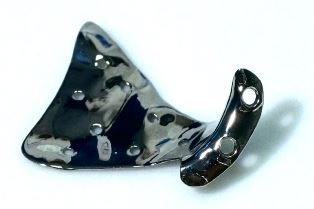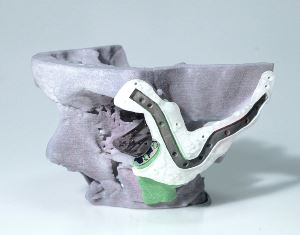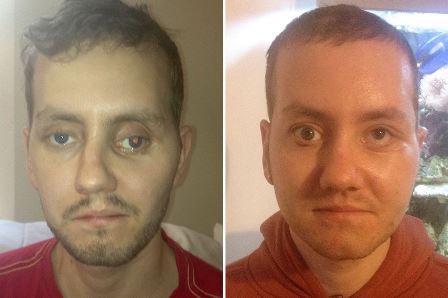Motorbike crash survivor’s face reconstructed with 3D printed titanium implant
13 March 2014
A specialist team at the Morriston Hospital in Swansea has successfully implanted a custom designed and printed titanium cheek bone and eye socket for a badly injured motorcyclist.
Motorcyclist Stephen Power broke both arms and his right leg in an accident and suffered major injuries to his head and face. He was unconscious for several months in hospital.
The team at the Morriston Hospital in Swansea successfully treated the facial injuries, with the exception of his left cheek and eye socket. The patient’s cheekbone was too far out and his eye was sunk in and dropped. Due to the close proximity of critical and sensitive anatomical structures, the team decided to apply the latest computer aided design and 3D printing techniques.
The imaging and design was done by PDR and Belgian company LayerWise manufactured the implant and fixation plate in medical-grade titanium (Ti6Al4V ELI) in accordance with the ISO 13485 standard.
“The reconstructive orbital floor plate plays an essential role in the repositioning of the eye in light of the targeted facial symmetry and eye alignment,” explained Romy Ballieux from LayerWise’s Medical Business Unit. “LayerWise produced the floor plate, and polished its upper surface to minimize friction with soft tissues. The floor plate was fixated to the zygomatic bone through the plate’s dedicated slip with attachment holes. The digital 3D printing technology successfully maintained the accuracy of the precise medical imaging data, pre-operative planning and implant design. The 0.1 mm (4 mils) geometric accuracy of the floor plate’s freeform surfaces could not be achieved using traditional manufacturing methods.”

Reconstructive titanium orbital floor plate,
produced by LayerWise

Custom-fitting guide holding the LayerWise
titanium fixation
plate in the correct position, and the
polished orbital implant
Accuracy is even more critical with regard to the fixation plate. This fairly long, slim, curved 3D printed plate requires precise positioning to be able to tie together many fractured bone pieces of the cheek region. A custom-fitting guide was used to fit securely around the anatomy, with slots located to guide the surgeon’s movement when positioning the plate. The fixation plate restored the correct anatomical connection between the frontal, zygomatic and temporal bone.
This connection contributed to the successful reconstruction of
the patient’s anatomy, providing the best possible facial symmetry.
Ballieux noted: “Dedicated medical engineering specialized in the
production aspects of metal 3D printing were key in achieving the
impressive facial reconstruction in such a short timespan. The
digital process resulted in the 3D printed implant and fixation
plate produced in a single manufacturing step in only a couple of
hours.”
Instead of using a hat and glasses to mask his injuries, Stephen Power is now able to do day-to-day things, go and see people, walk in the street, and even go to any public areas. The improved facial symmetry and alignment of his eyes, achieved with the implant and fixation plate, has made a big difference to the patient's quality of life.

The patient before and after facial reconstruction